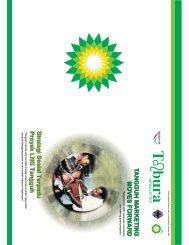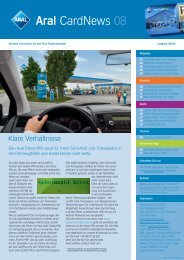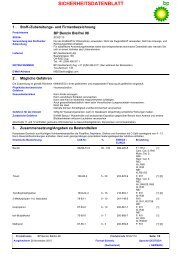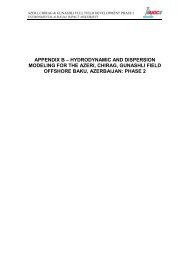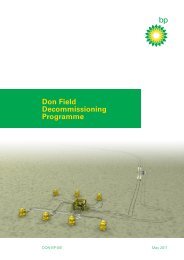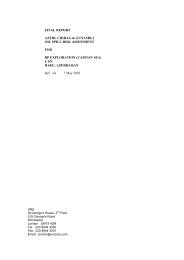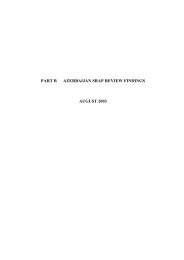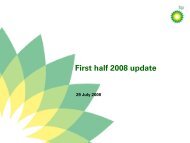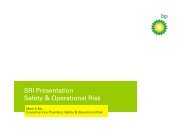Presentation slides and script (pdf, 2.6MB) | Investors - BP
Presentation slides and script (pdf, 2.6MB) | Investors - BP
Presentation slides and script (pdf, 2.6MB) | Investors - BP
You also want an ePaper? Increase the reach of your titles
YUMPU automatically turns print PDFs into web optimized ePapers that Google loves.
Hello <strong>and</strong> welcome everyone. This is <strong>BP</strong>’s third-quarter 2013 Results webcast <strong>and</strong>conference call.I’m Jessica Mitchell, <strong>BP</strong>’s Head of Investor Relations <strong>and</strong> I’m here with our GroupChief Executive Bob Dudley, <strong>and</strong> our Chief Financial Officer Brian Gilvary.Before we start, I need to draw your attention to our cautionary statement.2
During today’s presentation, we will make forward-looking statements that refer toour estimates, plans <strong>and</strong> expectations. Actual results <strong>and</strong> outcomes could differmaterially due to factors that we note on this slide <strong>and</strong> in our UK <strong>and</strong> SEC filings.Please refer to our Annual Report, Stock Exchange Announcement <strong>and</strong> SEC filings formore details. These documents are available on our website.Thank you, <strong>and</strong> now over to Bob.3
Thanks Jess <strong>and</strong> welcome everyone - no matter where you are in the world or whattime it is – thank you for joining us.4
July to September this year was another big step in moving towards both ourmedium <strong>and</strong> long term goals at <strong>BP</strong>.We are reporting solid results in which the fundamental strength of our businesses isapparent despite the offsetting effects of divestments in the upstream <strong>and</strong> weakerrefining margins in the downstream.In terms of business outputs we are strongly focused on delivering our 2014operating cash flow objectives <strong>and</strong> since we last spoke have continued to seemomentum in the business drivers that will deliver this growth.Beyond 2014 we have confidence in our ability to deliver sustainable growth in freecash flow. This will come through continued growth in operating cash from ourunderlying businesses <strong>and</strong> a strong focus on capital discipline.It underpins our decision today to increase the dividend <strong>and</strong> gives us confidence thatwe can sustain a progressive dividend policy over the long term.A year ago we also started talking with you about how we are reshaping <strong>BP</strong> to createa platform for growth that is simpler, more focused <strong>and</strong> which offers a differentiatedproposition by only investing in a strong pipeline of projects <strong>and</strong> opportunities thatplay to our strengths. In keeping with this approach we have also announced today acommitment to a further $10 billion of divestments by the end of 2015, from whichproceeds we plan to increase distributions to shareholders, primarily throughbuybacks.5
So today’s agenda, will follow a familiar pattern. Brian will take youthrough the third-quarter numbers <strong>and</strong> the implications of today’sannouncements on our financial framework.I’ll then give you an update on the legal proceedings in the US <strong>and</strong> theprogress of our investment in Rosneft, <strong>and</strong> then we’ll give you theheadlines of business progress upstream <strong>and</strong> downstream beforeopening things up for questions.So now, over to Brian.5
Thank you Bob.6
Starting with an overview of the third-quarter financial results.Underlying replacement cost profit in the third quarter was $3.7 billion, down 26% onthe same period a year ago <strong>and</strong> 36% higher than the second quarter of 2013.Compared to a year ago, the result mainly reflected:– The impact of divestments in the Upstream offset by higher realisations;– Lower Downstream refining margins compared to the near-record levels seen ayear ago <strong>and</strong> the absence of earnings from the divested Texas City <strong>and</strong> Carsonrefineries;– And a lower contribution from our shareholding in Rosneft compared to that fromTNK-<strong>BP</strong>.Third-quarter operating cash flow was $6.3 billion.As Bob noted, in line with our commitment to a progressive <strong>and</strong> sustainable dividendpolicy, we have also announced an increase in the third quarter dividend of 5.6% to9.5 cents per ordinary share, payable in December. This reflects our confidence insustainable free cash flow growth, underpinned by the strong operational progresswe are now seeing <strong>and</strong> a continued focus on capital discipline. Moving forward, theBoard will review the dividend level with the first <strong>and</strong> third quarter results each year.Turning to the highlights at a segment level.7
For the Upstream, the underlying third-quarter replacement cost profit before interest<strong>and</strong> tax of $4.4 billion was unchanged from a year ago <strong>and</strong> compares with $4.3 billionin the second quarter.The result versus a year ago reflects lower production due to divestments, primarilyin the Gulf of Mexico <strong>and</strong> the North Sea, <strong>and</strong> higher non-cash costs for explorationwrite-offs <strong>and</strong> DD&A.These effects were offset by−−−Higher liquids <strong>and</strong> gas realisations;Improved underlying volumes in high-margin regions; <strong>and</strong>A one-off benefit in the current quarter from cost pooling settlement agreementsbetween the owners of the Trans Alaska Pipeline System, or TAPS.Excluding Russia, reported production versus a year ago was 2.3% lower primarilydue to the impact of divestments. However on an underlying basis, after adjusting fordivestments <strong>and</strong> entitlement effects, production increased by 3.4%. This underlyinggrowth reflects new major project volumes in the North Sea <strong>and</strong> Angola as well asthe absence of seasonal weather-related downtime in the Gulf of Mexico.Compared to the second quarter, the result reflects:8
−−Higher liquids realisations <strong>and</strong> the benefit of the TAPS costpooling;Partly offset by higher non-cash costs, lower gas realisations <strong>and</strong>lower production.On the back of stronger-than-expected third-quarter production,benefiting from the absence of seasonal adverse weather in the Gulfof Mexico, we now expect fourth-quarter reported production to bebroadly flat with the third quarter <strong>and</strong> costs to be higher with theabsence of the TAPS pooling settlement benefit.8
This slide shows our share of earnings from Rosneft, <strong>and</strong> historically from TNK-<strong>BP</strong>.<strong>BP</strong>’s share of Rosneft underlying net income was over $800 million in the thirdquarter, significantly higher than in the previous quarter. The third quarter benefitedfrom rouble appreciation against the US dollar, a positive duty lag <strong>and</strong> higher Uralsprices, partially reversing the negative impact of these factors in the second quarter.<strong>BP</strong>’s share of Rosneft production in the third quarter was 965 thous<strong>and</strong> barrels of oilequivalent per day, 2% higher than in the previous quarter. <strong>BP</strong>’s total production forthe quarter, including this production, was 3.2 million barrels of oil equivalent per day.In the third quarter we received around $460 million after tax from our share of theRosneft dividend that related to last year’s earnings. We expect no further dividendsfrom Rosneft this year.9
In the Downstream, the third quarter underlying replacement cost profit beforeinterest <strong>and</strong> tax was $720 million compared with $3.0 billion a year ago <strong>and</strong> $1.2billion in the second quarter.The Fuels business reported an underlying replacement cost profit of $345 million inthe third quarter, compared with $2.7 billion in the same quarter last year reflecting:– A significantly weaker refining environment versus the near-record levelsexperienced in the same period last year; <strong>and</strong>– The absence of earnings from the divested Texas City <strong>and</strong> Carson refineries in theUS which delivered unusually strong results in the third quarter last year due tothe favourable environment.The Lubricants business reported an underlying replacement cost profit of $325million compared with $310 million in the same quarter last year, demonstrating thestrength of our premium Castrol br<strong>and</strong>s.The Petrochemicals business reported an underlying replacement cost profit of $50million compared with a loss of $20 million in the same period last year, with somecontribution from increases in utilisation <strong>and</strong> unit margins.Looking forward to the fourth quarter, we expect Fuels profitability to remain undersignificant pressure due to weak refining margins. This is due to a combination ofhigh gasoline stocks on both sides of the Atlantic, new competitor capacity additionsas well as lower seasonal dem<strong>and</strong>.10
In Other Businesses <strong>and</strong> Corporate, we reported a pre-tax underlying replacementcost charge of $380 million for the third quarter.Guidance for the year remains a charge of around $500 million on average perquarter, however this can be expected to be volatile from quarter to quarter.The underlying effective tax rate for the third quarter was 31% compared to 34% ayear ago, benefiting from−−−A one-off adjustment of $100 million for changes in UK tax rates;Higher equity-accounted income; <strong>and</strong>Beneficial income mix effects.Full-year guidance for the underlying effective tax rate remains in the range of 36 to38%.11
ThechargefortheGulfofMexicoprovision increased by $40 million in the thirdquarter due to the ongoing costs of running the Gulf Coast Restoration Organisation.The total cumulative net charge for the incident to date is now $42.5 billion. Thisincludes the cost of the $20 billion Trust Fund for which a charge was recognised in2010.The charge does not include any provision for future business economic loss claimsthat have yet to be received or processed within the Plaintiffs’ Steering Committeesettlement. In addition, as a result of the recent Fifth Circuit ruling that Bob will talk toshortly, we are now no longer providing for outst<strong>and</strong>ing business economic lossclaims offers that are yet to be paid. $400 million of previously provisioned businessoffers were therefore derecognised in the third quarter as they can no longer bemeasured reliably. We will continue to revisit this in each quarter.As a result of this change, at the end of the third quarter the cumulative amountestimated to be paid from the Trust Fund decreased by $400 million to $19.3 billion.This increased the unallocated headroom available in the Trust for furtherexpenditures to $700 million. In the event the headroom is fully utilised, subsequentadditional costs will be charged to the income statement.The cash balances in the Trust <strong>and</strong> the Qualified Settlement Funds amounted to $7.1billion, with $20 billion contributed in <strong>and</strong> $12.9 billion paid out.The pre-tax <strong>BP</strong> cash outflow related to oil spill costs for the quarter was $400 million.As we have indicated in previous quarters, we continue to believe that <strong>BP</strong> was notgrossly negligent <strong>and</strong> have taken the charge against income on that basis.12
With respect to our divestment programme, we have continued to focus our portfolioduring 2013.We have completed the $38 billion divestment programme <strong>and</strong> the sale of our shareof TNK-<strong>BP</strong> to Rosneft for $27.5 billion.This brings the total divestments announced since the start of 2010 to around $66billion including TNK-<strong>BP</strong>, which can be seen in the context of our $135 billion marketcapitalisation today.Following receipt of the net cash proceeds of around $12 billion from the divestmentof our share in TNK-<strong>BP</strong> we announced an $8 billion share buyback programme <strong>and</strong> asof the 25 th of October, we have repurchased $3.8 billion of shares for cancellation.We now plan to divest a further $10 billion of assets by the end of 2015, as a meansof unlocking further value as we continue to focus our portfolio. The cash proceedsafter-tax will be predominantly linked to additional shareholder distributions, with abias to share buybacks.13
Moving now to cash flow, this slide compares our sources <strong>and</strong> uses of cash in thefirst nine months of 2012 <strong>and</strong> 2013.Operating cash flow in the first nine months was $15.7 billion, of which $6.3 billionwas generated in the third quarter. Excluding oil spill related outgoings, underlyingcash flow in the first nine months of 2013 was lower than a year ago. Year-to-datecash flow has been impacted by a working capital build of around $5.5 billion whichwe would expect to unwind over time.In the third quarter we received $400 million of divestment proceeds bringing thetotal for the first nine months to $16.7 billion. This includes the net cash receivedfrom the divestment of our share in TNK-<strong>BP</strong>.Organic capital expenditure was $17.5 billion in the first nine months <strong>and</strong> $5.9 billionin the third quarter.14
Net debt at the end of the third quarter was $20.1 billion with gearing of 13.3%compared to 20.9% a year ago.Our intention remains to keep gearing in a target b<strong>and</strong> of 10 to 20% whilstuncertainties remain.15
This slide outlines our financial framework for 2014 <strong>and</strong> beyond.We continue to expect operating cash flow of $30-31 billion in 2014, representingmore than 50% growth in operating cash flow versus 2011.In line with continued capital discipline, we expect<strong>BP</strong>’scapitalspendingin2014toremain at around the same level expected for this year, in the range of $24 to $25billion. Beyond that we expect annual gross capital expenditure to be in the range of$24 to $27 billion through to the end of the decade.We are confident in our ability to deliver material growth in operating cash flowsbeyond 2014 coupled with continued capital discipline. This will enable us to growsustainable free cash flow to underpin progressive dividend growth into the future.We expect to divest a further $10 billion of assets before the end of 2015 <strong>and</strong> to usethe post-tax proceeds for distributions, primarily through share buybacks. Beyond2015 we will continue to actively manage our portfolio for value.And we expect to outline the financial shape of the firm beyond 2014 in an InvestorUpdate on the 4 th March next year.Now let me h<strong>and</strong> you back to Bob.16
Thanks Brian. I will now turn to the US legal outlook <strong>and</strong> an update on progress inRussia, before looking at milestones in our business segments.17
First an update on the status of legal proceedings in the United States.ThefirstphaseoftheMDL2179trialcommencedonthe25 th of February in NewOrleans, focusing on the causes of the accident <strong>and</strong> allocation of fault among thedefendants, <strong>and</strong> ended on the 17 th of April. While the Court will ultimately decide, webelieve that the evidence showed the accident was the result of multiple causes,involving multiple parties.The second phase of the trial commenced on the 30 th of September, <strong>and</strong> completedjust 11 days ago on the 18 th of October. This phase involved two main issues –source control, including attempts to stop the flow of oil from the well, <strong>and</strong> thequantity of oil spilled into the Gulf of Mexico. As it did after the conclusion of Phase1, the Court has ordered post-trial briefings, which will be completed by the 24 th ofJanuary, 2014. Again, while the Court will ultimately decide, we believe that theevidence showed that <strong>BP</strong> mounted an extraordinary response, was neither negligentnor grossly negligent in its source control efforts, <strong>and</strong> the government’s flow rateestimates are substantially overstated.We do not know when the Court will issue a ruling on either Phase 1 or Phase 2issues.The penalty phase, in which the court will hear evidence regarding the penalty factorsset out in the Clean Water Act, will be the next phase of the trial. The USgovernment, <strong>BP</strong>, <strong>and</strong> Anadarko will be parties in this phase, <strong>and</strong> we anticipate that theCourt will schedule it sometime in 2014.18
TurningtothesettlementwiththePlaintiffs’ Steering Committee, asBrian mentioned earlier <strong>BP</strong> was successful in challenging the ClaimsAdministrator’s interpretation of the business economic lossframework. The Fifth Circuit reversed the interpretation <strong>and</strong> orderedthe District Court to enter a preliminary injunction that suspendspayments to claimants affected by the misinterpretation <strong>and</strong> who donot have “actual injury traceable to loss from the Deepwater Horizonaccident.”On the 18 th of October, the District Court issued the preliminaryinjunction to, among other things, temporarily suspend paymentsexcept where the Claims Administrator determines that the matchingof revenue <strong>and</strong> expenses is not an issue. While a step forward, <strong>BP</strong>continues to evaluate its options to ensure that the Fifth Circuit’sdecision, including its directives relating to causation, are given fulleffect. Further rem<strong>and</strong> proceedings are scheduled to take place bythe 2 nd of December.In the meantime, oral argument on the appeal pending in the FifthCircuit court related to the fairness of the settlement itself isscheduled for the 4 th of November.Separately, former federal judge Louis Freeh’s independentinvestigation of the claims facility continues, <strong>and</strong> we hope that it willlead to steps that ensure public confidence in the integrity of theclaims process.And finally, MDL 2185 is a coordinated proceeding pending in federalcourt in Texas, <strong>and</strong> includes a purported class action on behalf of ADSpurchasers under US federal securities law. A jury trial on this actionis scheduled to begin on the 25 th of August, 2014.In summary, we are well prepared for the long haul on legal matters<strong>and</strong> continue to compartmentalise these activities from the running ofour businesses so as not to distract our workforce from delivering onour business goals.18
In regard to Russia, as Rosneft noted last quarter, the work to integrate TNK-<strong>BP</strong> islargely complete including the Rosneft Board approval of their revised business plan,incorporating the year-to-date acquisitions.In the third quarter Rosneft paid its dividend, declared for 2012, with <strong>BP</strong> receiving itsshare – around $460 million. This was the first dividend since the transaction wascompleted in March of this year.And following my election to the Rosneft main board of directors in June, I have beenactively participating in the board’s activities, providing perspectives on how thecompany is progressing, including as a member of the board’s Strategic PlanningCommittee.Rosneft is also continuing to implement its strategy, including the acquisition of theremaining equity in Itera <strong>and</strong> its agreement to purchase gas assets in Yamal fromALROSA <strong>and</strong> Enel.Finally, most recently, Rosneft has initiated an offer to buy out the minorityshareholders in TNK-<strong>BP</strong> Holding.We will continue to keep you informed of Rosneft’s progress as it delivers on itsstrategy.<strong>BP</strong>’s interest in Rosneft enhances our own scale <strong>and</strong> capability. The effect of this onour key metrics is illustrated in the box at the foot of the slide. You will note how ourequity share in Rosneft takes <strong>BP</strong> to being a 3.2 million barrel a day company, witharound 17.5 billion barrels of proved reserves. More importantly, this strategicinvestment in Rosneft allows us access to growth opportunities previously19
unavailable to us in Russia, one of the world’s largest producers of oil<strong>and</strong> gas combined with unparalleled resource potential.We remain excited about what we can contribute from our ownexperience to support Rosneft’s potential <strong>and</strong> look forward todeepening our involvement wherever we can add value.19
Moving on, let me update you on progress in our Upstream.20
It was a great quarter for exploration. We made three discoveries – one in India, onein Egypt <strong>and</strong> another to announce just today in Angola. And we are keeping up ourbusy drilling programme.The discovery in India was our second there this year, this time in the Cauvery basin.Once again it was very deep – 5,700 metres below sea level.As with the KG-D6 discovery in 2Q, which we found underneath existing producingreservoirs, this new play has been identified using the detailed geoscience expertisethat we can bring to bear on our portfolio.The discovery in Egypt was also a significant <strong>and</strong> record breaking one - the deepestwell ever drilled in Egypt’s Nile Delta – called Salamat.On Block 20 in Angola the Cobalt-operated Lontra well reached total depth <strong>and</strong>confirms an oil <strong>and</strong> gas discovery. The well will be drill stem tested <strong>and</strong> the rig willmove to another structure on the block. We will likely have more information by yearend on Lontra.Overall we expect to complete between 16 <strong>and</strong> 18 exploration wells in 2013. So farwe have completed 12 wells <strong>and</strong> we have a further 8 in progress today, while interms of access we have continued to build our positions with new acreage in 3Q inChina <strong>and</strong> Brazil.21
Our Global Projects Organisation continues to make progress with ourmajor projects, with the third start-up of the year - more on which I’lltalk about in a moment in a moment, <strong>and</strong> we have five further majorprojects on track for start-up in 2014 - Na Kika 3 <strong>and</strong> Mars B in the Gulfof Mexico, Kinnoull in the North Sea, CLOV in Angola, <strong>and</strong> Sunrisephase 1 in Canada.So we’ve seen some important milestones in the last few months.But actually our major focus is not only on the discoveries or the startupsthat make the headlines - but on the safe, reliable execution ofwhat we do everyday in all of our operations around the globe.In our Global Wells Organisation, 80% of our top 15 wells are nowonline. In key regions such as Azerbaijan, North Sea <strong>and</strong> Angola,delivery of new wells is at or above 2012 levels.We’re also seeing similar improvements in our Global OperationsOrganisation where improvements in operations efficiency reflect thebenefit of investing in turnarounds.Wehavenowcompleted17ofthe21 turnarounds planned for the year.Going forward we expect the level of planned turnaround activity tocontinue to fall following the last couple of years where we havecarried out significant turnarounds on many of our key assets in manycountries.21
So moving on, let me update you in more detail on our Major Projects.Our key 2012 start-ups continue to ramp up their production as planned <strong>and</strong> we havestarted up three more major projects in 2013. As I mentioned, the North Rankin 2field in Australia became the third of these, following the Atlantis North Expansion inthe Gulf of Mexico <strong>and</strong> the Angola LNG project. Chirag Oil, in Azerbaijan, is on trackfor start-up around the end of the year.Milestones are being passed on constructing or commissioning the start-ups that wehave planned for 2014. All projects in the 2012-2014 portfolio are either online or haveachieved over 75% of facilities completion with commissioning work happeningthereafter. These projects will, on average, deliver twice the operating cash margin ofthe upstream portfolio we held in 2011.Following the tragic events at the In Amenas facility earlier this year, we nowanticipate that the In Amenas <strong>and</strong> In Salah major projects will not be ready to start upin 2014 but we continue to work with the joint venture to bring these projects onlinea little later.Looking beyond 2014, we have a portfolio of over 15 major projects that are in thedesign or post-FID stage. In addition to these we have a hopper of over 20opportunities currently being appraised through resource <strong>and</strong> project appraisalactivity.Our strict discipline in the re-investment of capital from growing operating cashdelivery has led to redesign <strong>and</strong> continued challenge in our projects hopper. This has,increasedtheirvalueforyou<strong>and</strong>reflectscapital discipline. For example, in the GulfOf Mexico, in the second phase of our Mad Dog field development is being retooled<strong>and</strong> in Australia, where the Browse LNG project has been re-designed based on aFloating LNG concept.22
This is a brief round-up on a geographical basis, looking at four key regions that willunderpin growth in operating cash flow.In the Gulf of Mexico, we have completed the major brownfield replacement of thehurricane-damaged Mad Dog Rig, which means we now have eight rigs operating. Afurther rig, which we expect to have drilling on Atlantis by year end, is on locationundergoing acceptance testing. That’s the highest number of rigs engaged in drillingoperations in the Gulf since 2010.The Atlantis North Expansion – which started up in 2Q - is showing initial strongreservoir performance <strong>and</strong> production.The Mars B platform was installed in 3Q <strong>and</strong> work on the tension leg platform rig <strong>and</strong>commissioning activities for the topsides <strong>and</strong> subsea commissioning are progressingwell. Na Kika 3 is on track for start-up in early 2014 <strong>and</strong> drilling operations are nearcompletion, while turnarounds on three of our four hubs are now complete.In Angola, our Greater Plutonio asset has continued to show strong plant efficiency,averaging 95% year-to-date, while PSVM has ramped up to over 124 thous<strong>and</strong> barrelsper day. Angola LNG has now lifted its fourth cargo following the 2Q start-up.In the North Sea, Skarv is ramping up well, with production averaging over 148thous<strong>and</strong> barrels of oil per day, the offshore construction of Kinnoull is progressingwell with all of the topsides under-deck work having been completed <strong>and</strong> the finalsubsea tie-ins underway, <strong>and</strong> we have completed seven of the nine scheduledturnarounds.Finally in Azerbaijan, in August, we announced gas contracts for over 10 billion cubicfeet per annum over 25 years to nine different European gas buyers, via what we call 23
the Southern Gas Corridor, an important part of the value chain formonetising the future Shah Deniz Phase 2 gas development.As previously mentioned, we are making good progress with theChirag Oil Project, with the platform jacket set <strong>and</strong> the topsides safelyinstalled in September. Focus has now turned to the commissioningactivities in preparation for start-up around the end of the year.So in summary, during 3Q we have continued to deliver what we saidwe would in the Upstream - across exploration <strong>and</strong> access, projects,wells <strong>and</strong> operations. Our key regions continue to deliver a pipeline ofopportunities that, together with the rest of the portfolio, are set todrive a sustainable growth in operating cash flow.23
Now turning to the Downstream.24
This quarter we continued to progress the Whiting Refinery Modernisation Project asplanned <strong>and</strong> we remain on track to start up the coker in November.Across the refining portfolio, Solomon refining availability has remained high at95.3%, similar to the levels we saw at this time last year.In petrochemicals, construction on a new, third, PTA plant continues to progress atZhuhai in Guangdong province of China. We have also approved the first of a seriesof investments to retro-fit key elements of our latest PTA technology to existing PTAplants. We expect these planned investments to materially improve efficiency <strong>and</strong>reduce annual operating costs.And our Lubricants business has also continued to perform well, increasing revenuesthrough its strategy of exposure to growth markets, technology investments <strong>and</strong>targeted marketing programmes are underway. Over 50% of sales revenues are fromgrowth countries in 3Q 2013.25
The Whiting refinery has continued to bring units onstream during the third quarter.As previously announced, the crude unit started operations in 2Q, as planned. Sincethen, the gas oil hydrotreater, <strong>and</strong> the largest of two sulphur recovery units alongwith other supporting infrastructure have been commissioned.The Coker is planned to be brought online during November, as scheduled, <strong>and</strong> whencombined with the gas oil hydrotreater, significantly increases the ability of the plantto produce high yields of low sulphur fuels, from heavy, high sulphur, acidic crudes.Once the coker is online, we expect the refinery to begin a three month progressivetransition to heavy feedstock, reaching full run-rate capacity during in the first quarterof next year. The revamp of a small number of complementary existing units will alsotake place in 1Q.This major investment transforms Whiting into one of the key advantageddownstream assets in our portfolio <strong>and</strong> underpins the ability to deliver increased cashflow in 2014.26
And so to summarise, this was another quarter of moving ahead.We have recently launched operations such as PSVM in Angola <strong>and</strong> Skarv in theNorth Sea that are now producing strongly.We have projects gearing up to start up soon, such as the Chirag Oil Project, inAzerbaijan.We have future operations taking shape very well – such as Clair Ridge, also in theNorth Sea.AndweareseedingtheportfolioofthefuturewithdiscoveriessuchasthoseinIndia,Egypt <strong>and</strong> Angola.All of this Upstream activity is accompanied by a Downstream that continues toperform well in a tough climate <strong>and</strong> nears completion of the major upgrade at theWhiting refinery.27
These are all examples of the way we are putting our strategy into action.And to be clear, that strategy aims to deliver a very simple set of outcomes that youcan expect from us:That is material growth in operating cash flow from 2014 through the back of thedecade, coupled with a disciplined capital spending framework, to drive growth insustainable free cash flow in support of a progressive dividend policy.As well, we will look to use surplus cash to enhance distributions to shareholders.Today’s announcement with respect to further divestments <strong>and</strong> their linkage toincreasing buybacks is a good example of this.We are confident we will achieve these objectives by putting value before volume –with a portfolio of the right scale, shape <strong>and</strong> quality to drive safety, reliability,efficiency <strong>and</strong> performance. We will keep this portfolio constantly under review toachieve these objectives.This portfolio will play to the strengths we have developed over many years inexploration as well as deepwater, giant fields <strong>and</strong> gas value chains, as well ascontinuing to achieve very strong performance <strong>and</strong> cash generation from a verystrong set of downstream businesses.At the same time our holding in Rosneft forms an important part of our overallportfolio of assets <strong>and</strong> investments – it establishes us as a 3.2 million barrel per daycompany – <strong>and</strong> gives us a stake in an enterprise that is well placed to addressRussia’s massive potential in terms of energy resources, discovered <strong>and</strong>undiscovered.28
With that said I’d like to conclude with a few words on the bigger picture of whichthis is all part.Fifteen years ago <strong>BP</strong> <strong>and</strong> other majors embarked on the round of consolidation thatcreated the so-called super-majors. We then went through a phase of inorganicgrowth driven by the prospect of synergies <strong>and</strong> cost savings.In the last decade the super-majors have undertaken their first wave of globalinvestments with the objective of growing organically – by making discoveries,building portfolios <strong>and</strong> developing a new generation of projects.I saw the report that McKinsey circulated that the super-majors doubled their capexover eight years – from $60 billion in 2005 to around $130 billion in 2012.The question is whether the peer group can convert that wave of investment into theright level of cash flow <strong>and</strong> then repeat the cycle in successive waves. Right now Ithink it’s fair to say opinion is divided. But the investments are now coming onstreamrapidly <strong>and</strong> the answer to that question will become clearer in the next year or so.So we underst<strong>and</strong> that we have to prove ourselves capable of running major globalportfolios <strong>and</strong> balancing investment against returns.I think the approach we are taking in <strong>BP</strong>, with an intense focus on high-margin qualitygrowth <strong>and</strong> capital discipline, will prove to be the right one. I am confident that it willlead, as planned, to increasing cash flow, <strong>and</strong> a progressive dividend as part of thegrowth in returns that our investors expect <strong>and</strong> deserve.With that, thank you for your attention <strong>and</strong> now over to you for any questions.29


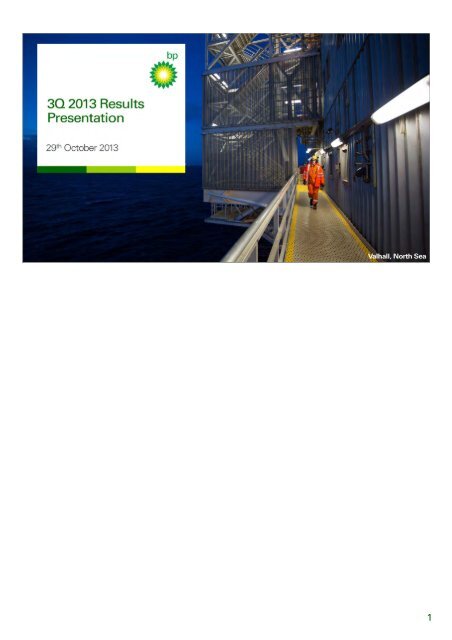

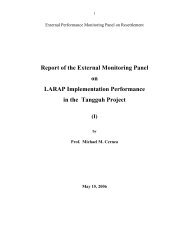
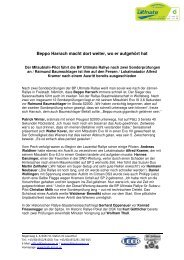
![[PDF] Deepwater Horizon: Accident Investigation Report - BP](https://img.yumpu.com/51697031/1/190x245/pdf-deepwater-horizon-accident-investigation-report-bp.jpg?quality=85)
